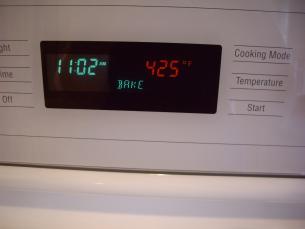Have you ever tried to cook frozen French fries in the oven without preheating the oven? The directions often say preheat to 425 degrees. That can take 15 to 20 minutes. So, after 10 minutes, you lose your patience and in the oven they go. Big mistake! Your French fries take forever to get crispy!
Today I’m going to talk about “conventional” oven settings.
There are many recipes for making fish, chicken, nachos, etc., that will say bake and others that say broil as a method of cooking. Do not confuse them. These are two very different ways to prepare food. With “baking” you always have to start with preheating the oven.
Note from Jon Sacker: A quick translation for your British readers, or American readers of British recipes, broiling (US) = grilling (UK), which should not be confused with grilling (US) = barbequing (UK). Hope that helps :-}
Preheating
Preheating an oven is essential or you will throw off the cooking times. All cooking times are based on a preheated oven unless otherwise stated in the recipe. Luckily, when most (modern) ovens reach their desired temperature, they beep at you, or a light goes on or off. You then know it is OK to put food in the oven and start the timer.
Conventional ovens all have several settings. In addition to preheat, there is bake, broil, self-clean (if you are lucky!) and some ovens even have a ‘warming drawer.’
Before turning the oven on, make sure the oven racks are in the desired position. It’s easier to move the racks in a cold oven; you are less likely to get burned that way! Baking is usually done in the middle of the oven. Broiling (see below) is usually done closer to the top of the oven.
Bake
Baking is used to cook things like chicken, potatoes, fish, stews, cookies and cakes. Food gets cooked from the outside in. (Unlike a microwave which causes food molecules to vibrate, creating friction that heats and cooks the food in all directions at once.) You check for “done-ness” by examining the internal temperatures, for example by sticking an oven thermometer into the food. While your food is baking, try not to open the door too often to check for done-ness. Every time you open the oven door to see if your food is cooked, your oven temperature will drop and extend the cooking time.
Oven Temperature Metric Conversion Chart:
| Farenheit | Celsius | Gas Mark |
|---|---|---|
| 275º F | 140º C | gas mark 1-cool |
| 300º F | 150º C | gas mark 2 |
| 325º F | 165º C | gas mark 3-very moderate |
| 350º F | 180º C | gas mark 4-moderate |
| 375º F | 190º C | gas mark 5 |
| 400º F | 200º C | gas mark 6-moderately hot |
| 425º F | 220º C | gas mark 7- hot |
| 450º F | 230º C | gas mark 9 |
| 475º F | 240º C | gas mark 10- very hot |
Broil
Broiling means to cook food (like steaks, hamburgers, chicken breasts) under very direct heat. With a gas oven, you actually see a flame. An electric oven has coils directly above the food. My oven insists the door be closed for the broil to work. Some ovens you have to leave the door open. The oven manual should tell you what works with your oven.
Obviously, the closer you are to the heat source – the higher the heat. If you have positioned the racks too close to the broiler, your steak may get burned on the outside and still be raw on the inside. Many recipes will tell you how far away from the broiler you should be.
Do make sure that the baking dish you are using is safe to put under the broiler. Pyrex dishes are NOT broiler safe and could possibly explode from the intense heat of the broiler!
You can also broil things on an outdoor grill over charcoal or some other heat source. I have been to many barbeques but I have never actually done any outdoor grilling myself! We live in a condominium and don’t do outdoors very well!
Warming Drawer
As noted above, your oven may have a warming drawer. If you are having a dinner party, this is a great place to keep the food warm while waiting for your guests to arrive. The food is kept warm at a very low temperature. As I don’t actually use it very often, I store cooking equipment in my warming drawer.
I hope this brief introduction to conventional oven settings was helpful.
Cheers!
Kathy
If you are new to startcooking, or are a regular visitor here, please consider subscribing for free.









































Jon Sacker said:
A quick translation for your British readers, or American readers of British recipes, broiling (US) = grilling (UK), which should not be confused with grilling (US) = barbequing (UK). Hope that helps :-}